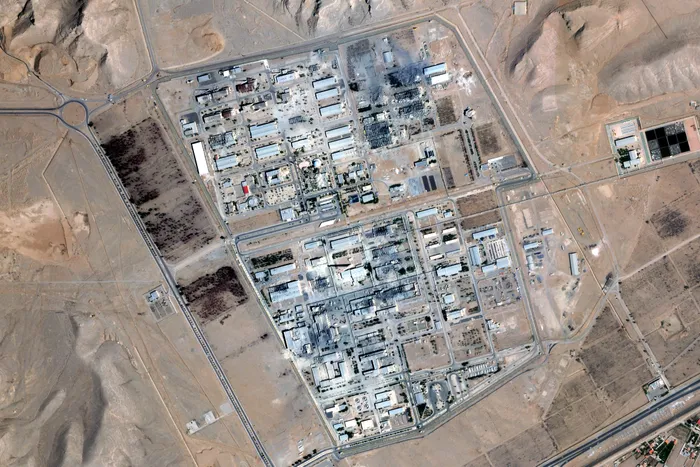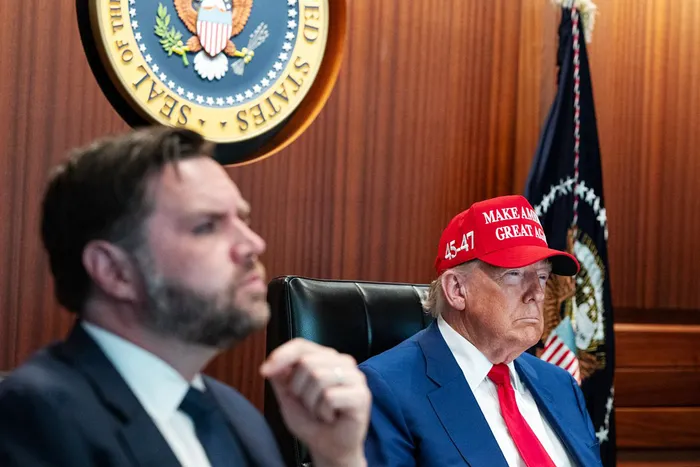
A satellite photo shows the Isfahan nuclear enrichment facility in central Iran after US strikes.
Image: Planet Labs PBC / AFP)
Marc Champion
Donald Trump’s decision to bomb Iran’s hard-to-reach nuclear site at Fordow couldn’t have worked out better. Operationally, it was flawless, and the response it drew from Iran was the best the US president could have hoped for - bloodless and de-escalatory by design. Most important of all, Trump then tried to bounce Israel and Tehran into a ceasefire. Kudos where it’s due.
And yet, this is not over. There will be more tough decisions for the White House to make, with profound implications for the cause of nuclear non-proliferation.
The problem here isn’t that the ceasefire announced on Monday night was breached within hours. That’s hardly unusual and, in this case, there’s a good chance it takes hold over the coming days. Israel has run through most if not all of its target list; Iran is running low on ways to meaningfully respond without putting the regime’s survival at risk. Even so, we aren’t where Trump says we are.
Trump says his ceasefire will hold for all time, but there will be no forever-peace between the Islamic Republic and Israel. No doubt, Supreme Leader Ali Khamenei and his politically powerful generals will take time to regroup and lick their wounds. They’ve suffered a severe military humiliation, and there will be some form of reckoning at home. But hostility to Israel is in their political DNA. There is no one-and-done here.
Nor has Iran’s nuclear programme been wiped from the face of the earth, never to be rebuilt, as Trump claims. Let’s say all the enrichment equipment at the sites that the US and Israel bombed over the last 10 days have indeed been destroyed. That’s as-yet unknown except to the Iranians, but it seems very plausible. The point, however, has always been that Iran has the know-how and capacity to replace whatever gets destroyed.
We also don’t know the whereabouts of Iran’s stockpile of uranium enriched to 60%, a short step to weapons grade. Nor can even Mossad be sure there are no sites that were missed because they simply weren’t known. These are just some of the reasons for which US presidents resisted bombing Iran’s nuclear programme in the past, preferring to achieve delays and visibility through diplomacy.

US President Donald Trump (Right) and Vice President JD Vance (Left) in the Situation Room of the White House on June 21 as the US military attacked three Iranian nuclear sites, including the underground uranium enrichment facility at Fordow. "We have completed our very successful attack on the three Nuclear sites in Iran," Trump said on his Truth Social platform. Experts disagree.
Image: WHITE HOUSE / AFP
In other words, the risk that Iran acquires a nuclear arsenal remains. It will continue until the day that either this regime or a successor decides not to pursue one. And right now, there’s no doubt - even if hardline officials weren’t saying so in public - that the argument for Iran to get itself a nuclear deterrent has never been more compelling. Nobody, after all, is bombing North Korea.
The attractions of acquiring a bomb have been clear for a long time, and not just to Iran. That’s why the 1968 Treaty on the Non-Proliferation of Nuclear Weapons, or NPT, exists. The system had its share of failure - North Korea, India, Pakistan and Israel itself - but granted that the technology to build nuclear weapons has long been within the scope of most of the treaty’s 191 signatories, and three of the four outliers never signed up, the list is mercifully short.
The NPT’s primary tool has been the International Atomic Energy Agency in Vienna. Though disparaged by many hawks in Washington and Israel, this has become a unique depository of expertise and provided the means to keep eyes on Iran’s program. Of course, Iran could and did avoid full compliance, and the threat of force always hovered in the background. It also took national intelligence agencies to expose that the Iranians even had an enrichment programme for the IAEA to monitor, in 2002.

Rafael Grossi, Director General of the International Atomic Energy Agency (IAEA), arrives for the Board of Governors meeting at the agency's headquarters in Vienna this month. American strikes on Iran's nuclear programme have made the agency's work substantially more difficult.
Image: Joe Klamar / AFP
Nonetheless, the NPT and IAEA have together provided a constraining framework for proliferation that would be sorely missed. In a might-makes-right, “(name-your-nation) First” era, it’s already in trouble. It may not be able to survive, much as Cold War arms-control treaties have been abandoned, one after the other, until today only one - New Start - remains, and it expires next year. The choices Trump makes now will play a big role in either accelerating or slowing the NPT’s demise.
One route would rely on intelligence agencies and military action to counter proliferation, in place of diplomacy. This was always the implication of Trump’s decision to collapse the 2015 Iran nuclear deal. It’s also the scenario Vice President JD Vance sketched out on Monday, when he warned that if the Iranians “want to build a nuclear weapon in the future, they’re going to have to deal with a very, very powerful American military again.” In Gaza, Israel called this approach “mowing the lawn,” but as the tragedy of Oct. 7, 2023, showed, that’s no guarantee of success. And how many lawns does the US want to mow?
Relying solely on the threat of force also assumes that Iran doesn’t learn a few critical lessons from the drubbing it just received. The first is to clean house, rooting out the Israeli intelligence assets that made its airstrikes so devastating. Expect a period of extreme regime paranoia. A second is to buy a much more capable air-defense system. A third will be to replenish its missile and drone arsenals. Absent a diplomatic track, there will also be no incentive for Iran to allow further international inspections. It’s already accusing the IAEA of complicity with the US and Israeli assaults.
Other countries will draw their own conclusions. The agreement was based on a grand bargain in which the existing five nuclear powers were supposed to disarm, while non-nuclear nations agreed to stay that way. Disarmament went a considerable distance, but in recent years has been thrown into reverse. US actions in first reneging on the 2015 deal with Iran, and then bombing it, won’t inspire confidence.
The alternative path Trump could take is to restart nuclear negotiations in the clear expectation that the Iranians won’t simply capitulate. There will have to be something in it for them. That means Trump and his team will face many of the same questions as they did before what’s been, in reality, just the hottest stage to date in a long-running Iran-Israel war. Those include whether to lift at least some economic sanctions and whether to accept a heavily monitored civilian grade enrichment programme, limited to 3.5% fuel.
Of course the Islamic Republic could collapse, to be replaced by something less fanatical. That’s an outcome that very few would mourn, but you don’t plan for luck. Trump needs to assume that Iran will now learn, rearm and refocus its nuclear program to produce a weapon as quickly and quietly as possible. Diplomacy and inspections remain the best and least hazardous way to prevent that. | Bloomberg
- Marc Champion is a Bloomberg Opinion columnist covering Europe, Russia and the Middle East. He was previously Istanbul bureau chief for the Wall Street Journal.